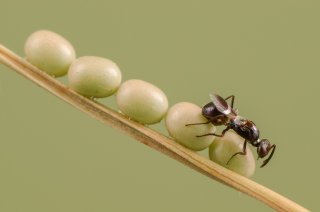
News
Finishing the first chapter: Non-target effects of a native parasitoid
In this year’s June issue of the Journal of Pest Science the first paper of my PhD will be published, but it can already be found online (open access: https://link.springer.com/article/10.1007/s10340-018-0969-x).
ESR update - Assessing the potential of native natural enemies before considering the introduction of exotic biocontrol agents has been standard practice for the last decades. For native natural enemies the test procedures are less strict, since the insects are already naturally present in the areas they should be released in. However, pests like the brown marmorated stink bug (Halyomorpha halys) that have invaded a new area (like in our case Europe) are often attacked by generalist natural enemies that are able to develop on a broad range of hosts. This means that releasing high numbers of generalist native natural enemies can temporarily impact populations of non-target hosts.
In our example, the potential native biocontrol agent is Anastatus bifasciatus, parasitizing the eggs of the target, the brown marmorated stink bug. The tested non-target species included nine European stink bug and nine-teen Lepidoptera species. While only tested under laboratory conditions, the parasitoid developed on all but five of the twenty-eight non-target species. Accordingly, mass releases of Anastatus bifasciatus against the brown marmorated stink bug may potentially have local, temporarily limited negative effects on native bugs, butterflies and moths. However, the impact of the parasitoid in the field may be different, and a more elaborate risk assessment under field conditions should be considered.
For me personally it marks the temporary end of a long journey (really a lot longer than I originally anticipated) from conducting the experiments over almost two years, analysing the data, writing the paper, submitting, revising, resubmitting to finally publishing. Indeed I would have never been able to finalize the study without the immeasurable support of my supervisors, the students, friends and colleagues that helped me with the experiments.
Experiencing the whole process for the first time had me going through periods of (including, but not limited to) excitement, frustration, doubt, hope, desperation, surprise and careful elation, and while (in hindsight) thoroughly appreciating the whole journey and all the things I learned I hope the next chapter will be less of an emotional roller coaster.
